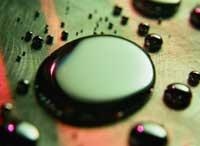“Electronic language” and heavy metals
2010/05/30 Aulestiarte Lete, Izaro - Elhuyar Zientziaren Komunikazioa

The organoleptic characteristics of everything that surrounds us are directly related to its chemical composition. The presence of different substances, at a certain level of concentration, also reports the color, smell or flavor in the air that we eat, drink or breathe (also to body cleaning products, among others). And each of these compounds has their own properties clearly defined.
Thus, when for the first time they come into contact with a substance, our senses relate the sensations detected with the presence of this chemical. And this information processed and accumulated in our brain is of vital importance, since this information will allow us to identify them when we repeat contact with these compounds. If confused in definite proportions, they create a new and unique sensory pattern that our brain “feels” and “stores”. We thus know what we are eating, drinking or smelling, while at the same time we can associate them with enjoyable, bad or dangerous previous experiences.

In our language there are taste buds that detect basic flavors. On the contrary, the new analytical tools incorporate a set of sensors that collect the sample information. (Photo: Mike Burns).
Therefore, it is usually said that the most perfect analytical tools are our senses. And, with the aim of equaling that “perfection”, the “electronic senses” are being built in recent times on the basis of the principles of recognition of human senses. This type of analytical instruments include a set of sensors that collect sample information, acting similarly to the taste buds of our languages. In the human tongue are the taste buds that detect basic flavors; when the molecules with flavors excite the nerves of the papillae, the signal is sent to the brain, where the flavor is identified.
Well, the sensors of the “language” of the Madrid researchers have sulfur atoms. These sulfur atoms tend to give electrons, in this case they deliver them to the metals and, in some way, react with them. These sensors are not specific, which means that it not only supplies electrons to a metal but to several. Therefore, this electronic language can detect several metals.
Easy, fast and accurate
Like the “electronic tongue” are applied with liquid samples, in recent times “electronic noses” have been developed for gases. According to experts, both are low-cost analytical methods compared to current ones, which provide results quickly and easily and with adequate accuracy.

Devices are used in multiple fields, such as clinical samples or to classify water, wine, soft drinks, beer, milk, tea or coffee. The industrial or environmental analysis allows to characterize the degree of toxicity or contamination of a sample by means of well-designed electronic devices, as well as to detect the variation in the concentration of several substances.
Members of the Autonomous University of Madrid, among others, have detected mercury using the “language” and are satisfied with the results obtained. It could be an effective alternative to complex methodologies so far.
Published in 7K.

Gai honi buruzko eduki gehiago
Elhuyarrek garatutako teknologia






